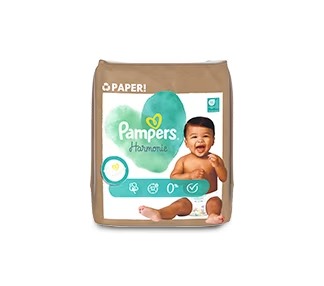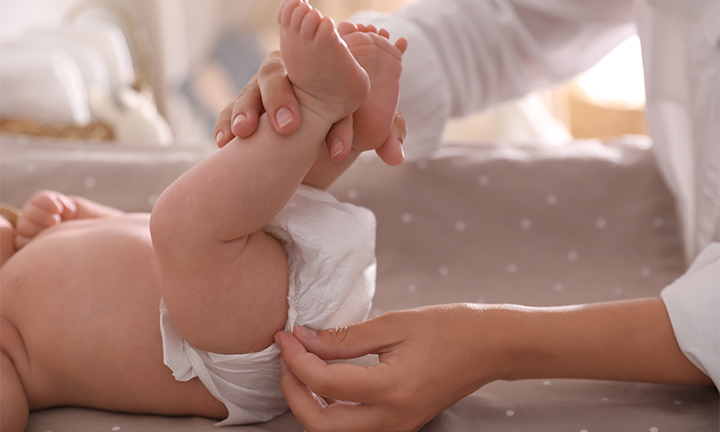
Your Baby Wee and Wet Nappy Guide: Colour, Smell and Frequency
Understanding your newborn’s urine and wet nappies is essential for monitoring your their health and hydration. In the early days, babies may only have 1 to 2 wet nappies, but by day five, 6 to 8 wet nappies daily is a sign they are feeding well and staying hydrated. Healthy baby wee is typically light yellow and odourless. Dark yellow or orange urine may indicate some dehydration, while red, pink or cloudy urine can signal more serious issues like infections or kidney concerns. Urate crystals, appearing as reddish stains (‘brick dust’), are common in the first week but should be monitored.
Here’s a quick guide to baby wee and wet nappies:
Pay attention to the frequency, colour and smell of your baby’s urine – this can offer early clues about your baby’s wellbeing. Keep reading to learn more in our comprehensive guide.
How Many Wet Nappies Should a Newborn Have?
Within the first 24 hours after birth, your newborn will likely urinate once, resulting in one wet nappy. As your baby begins to consume more milk in the days that follow, the number of wet nappies will increase. After about a week, a typical weeing routine for a baby results in about 6+ wet nappies daily.
Keeping track of the number of wet nappies each day can help you understand your baby's usual routine and indicate how they are doing. There is a broad range of healthy urinary frequency for a baby, with some weeing every one to three hours and others just four to six times a day. Generally, aim for around six wet nappies per day.
What Does It Mean if Your Baby Is Weeing a Lot?
If your baby seems to be weeing a lot, that's typically a positive sign and usually means they are getting enough nourishment. During your baby's first month, if you are breastfeeding and your milk supply is well-established, six or more wet nappies a day generally indicate that your baby is receiving adequate nourishment.
However, if you notice your baby is urinating much more than what's considered ‘normal’ (such as more than once every hour), look for other signs and contact your child's GP or health visitor if you have concerns. For instance, children with a urinary tract infection (UTI) may wee more frequently or display signs of pain or discomfort while urinating, such as crying or body tension.
What Does It Mean if Your Newborn Is Not Weeing?
After the first week, if you notice your newborn isn't urinating very often (fewer than four times a day), your baby might:
With illnesses, fevers or hot weather, your baby's urine output may reduce by half, which is actually quite normal. Once your baby's health improves and the weather cools, they will likely return to their typical routine.
If your newborn isn’t eating enough, however, that's another reason they might not be urinating much. When breastfeeding your baby, it can be tricky to gauge how much they’re consuming. Look for other signs that your baby isn’t getting enough to eat, which (alongside not weeing or pooing) may include:
Of course, if your newborn is still not urinating after a fever breaks or a heatwave has passed, when no illness persists or after feeding, contact your child’s GP as soon as possible, especially if your baby doesn’t wee at all within a span of six to eight hours.
Newborn Urine Colour
Baby urine is similar to adult urine, in that the urine of healthy newborns has a light to dark yellow colour. Darker shades indicate concentrated urine, which may mean your baby is slightly dehydrated. However, a normal wee colour for a newborn is a shade of yellow.
Your little one’s urine may have a slightly different colour from time to time. Many colours are entirely normal and usually nothing to worry about, whereas others may indicate a problem.
You’ll find a baby urine colour chart below, and we’ll also provide information about various shades of newborn wee, which can include tints of light yellow, dark yellow, pink, red, orange or brown.
Light to Dark Yellow Baby Wee
As mentioned above, light yellow urine is healthy. It means your baby is getting enough nourishment and weeing regularly. The darker the yellow colour, the more concentrated the urine. Although a healthy baby can have dark-yellow urine, this colour could also indicate that your little one needs to consume more liquids to stay hydrated.
Bear in mind that babies younger than 6 months should drink only breast milk or formula to stay hydrated. Once your little one turns 6 months old, you can start introducing small amounts of water.
Pink, Orange, Red or Brown Baby Wee
A pink, orange, red, or brown hue to your baby’s wee can mean a few different things. Some conditions are temporary, some are harmless, while others require medical attention.
Pink
It’s easy to assume that a pink spot on your baby’s nappy is blood, but this is often just highly concentrated urine. As long as your baby is weeing a lot, then there’s likely no cause for concern. However, if this colour persists, contact your child’s GP.
For a newborn baby girl, a pinkish stain on the nappy could indicate blood in the baby's wee, but it’s typically temporary and caused by the mother’s hormones. If your baby girl continues to have pink spots on her nappy or pink wee after she turns 1 week old, contact her GP.
Orange, Red or Brown
An orange, red or brown tint may indicate the presence of blood in your newborn’s urine. Whether you have a baby boy or a girl, blood in wee (after 1 week for girls) is not normal and usually means there’s a problem. The medical name for this condition is haematuria, and it can be caused by many things, including:
If you suspect blood in your newborn’s urine and see a pink, orange, red or brown tint, contact your child’s GP immediately. If it’s haematuria, their GP can address it quickly.
However, once your baby is past the newborn stage and you’ve introduced solid foods, these colours could be a result of your baby eating something colourful, like beetroots or blackberries. Either way, you’ll probably feel better once you contact their GP, who will identify the underlying cause and make sure your little one gets any necessary treatment.
Red or Brown and Cloudy Baby Wee
If your baby’s wee is cloudy and accompanied by a colour change, it could be a urinary tract or kidney infection. A kidney infection is a type of urinary tract infection (UTI), so they can often occur together. Contact your child’s GP if you notice any cloudy urine, especially if it also has a red or brown hue.
’Brick Dust’ Baby Wee
A common descriptor of a red-brown hue in baby wee is ‘brick dust’. It resembles dust from red bricks sprinkled into the urine, often mistaken for blood. When you see this in your baby’s wee, it could mean they’re not nursing enough or consuming enough formula. This ‘dust’ is urate crystals, which will not appear once your baby consumes more fluids and nutrients.
Baby Urine Colour Chart
Much like our colour chart for newborn baby poo, we’ve created one for wee, so you’ll have an easy guide as to what your baby’s urine may be telling you.
Baby Urine Smells
Along with concerns about your newborn’s wee colour, you may also wonder what it means when your baby's wee smells especially strong. Sometimes, colourful wee and smelly wee indicate the same thing.
Strong Smelling Urine in Babies
In some cases, strong, foul-smelling wee may indicate a bacterial infection, such as a urinary tract infection (UTI), which can cause serious illness if left untreated. When a baby’s urine smells particularly strong, kind of like ammonia, look for signs of an infection, which include blood in urine, plus cloudy and smelly 1ee. Babies with a UTI may also have a fever, start urinating a lot more frequently, or show signs of discomfort while urinating.
Toddlers can get UTIs, too, and when that’s the case, they may complain about pain while urinating, need to wee frequently, or have accidents during or after potty training. Consult your child’s GP if their wee smells foul or strong like ammonia, or if they have any of the above symptoms.
However, a strong urine smell doesn’t always indicate an infection. If your breastfed baby’s urine smells strong and is highly concentrated with a dark yellow colour, your little one may be dehydrated. Providing your baby with more fluids (either breast milk or formula) until 6 months old will typically suffice.
Diet and medication can also be reasons that a baby's wee smells strong. Check in with your child’s GP if you have any concerns about this.
Sweet-Smelling Wee
This may sound a little odd, but your baby’s wee might smell sweet like maple syrup. This odour indicates a rare, serious illness called Maple Syrup Urine Disease (MSUD), which typically shows signs either within the first three days of birth or between 5 months and 7 years. It’s a metabolic disorder that stops the body from properly converting food to energy.
Diabetes is another disease that could cause sweet-smelling baby wee. Because both diabetes and MSUD are severe conditions, contact your child’s GP if you notice a sweet smell to your baby’s urine.
FAQS AT A GLANCE
Healthy baby urine generally ranges from clear/light yellow to darker yellow. The darker the shade of yellow, the more concentrated the urine. So, if they have dark yellow wee, they may need to consume more liquids. Remember, babies under 6 months should consume only breast milk or formula, not water. At 6 months, you can start introducing water to your baby little by little.
The Bottom Line
As you’ve discovered, baby wee can sometimes be more complicated than just changing a nappy! Still, those daily nappy changes offer opportunities to monitor your little one's health. Pay attention to the number of wet nappies, the colour of your baby’s wee, and even the smell of your baby’s wee. This can help reassure you that your little one is doing well and staying hydrated, or you may notice signs that it’s time to contact your child’s GP. In summary:
Now that you understand the ins and outs of baby urine, you’ll have a better idea of how many wet nappies may come your way and when your baby’s urine (or lack of it) indicates a problem. In the meantime, download the Pampers Club app and reward yourself for all those nappy changes with Pampers Cash!
How We Wrote This Article The information in this article is based on expert advice found in trusted medical and government sources, such as the National Health Service (NHS). You can find a full list of sources used for this article below. The content on this page should not replace professional medical advice. Always consult medical professionals for full diagnosis and treatment.
Read more about Baby
Related Articles
Join Pampers Club and get:








